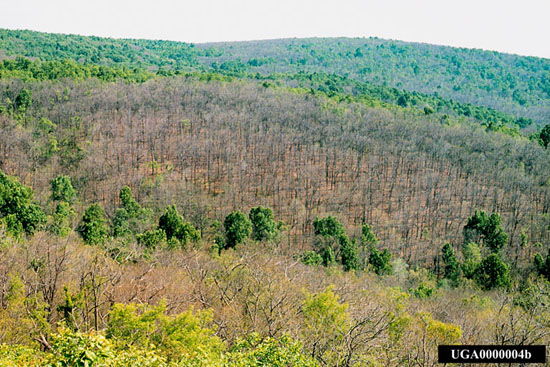blake
Life Member

Gypsy Moths Strengthen Foothold in <?xml:namespace prefix = st1 ns = "urn:schemas-microsoft-com
<st1:State w:st="on"><ST1
<st1:State w:st="on">Iowa </ST1
Gypsy moths, imported to <st1:City w:st="on">Boston</st1:City> in 1869 as an experiment to help provide silk for the textile industry, have become the most important defoliating insect of hardwood trees in the <ST1
In 2009, 82 adult male gypsy moths were captured in <st1:State w:st="on"><ST1
"Based on previous states' experience, we can expect to see the number of male gypsy moths captured in our traps to increase if we do not start managing this pest," said Tivon Feeley, forest health specialist with the Iowa DNR. "This is one pest that we know a lot about, but unfortunately, we don't know how to stop it, only how to control its populations."
<O
Foresters with the Iowa Department of Natural Resources will be working with the Iowa Department of Agriculture and Land Stewardship, <ST1
<O
"We are still at a low level of moths," said Feeley. "If we do not control these populations, we will start to see increased tree loss as the population expands."
<O
The damage is done in the caterpillar phase which runs from May through July, and the un-pleasantries extend beyond tree destruction. During those peak nuisance months, gypsy moth caterpillars crawl over homes, RVs in campgrounds, vehicles, outdoor furniture and lawns leaving waste from their feeding. The hairs on gypsy moth larvae can also cause allergic reactions to certain people causing rashes on the inside of legs and arms and abdomen.
<O
Economies Hurt
Defoliation caused by feeding caterpillars reduces the beauty that forests provide along scenic byways, state forests, and state and county parks in the area, and the recreational experiences for residents and visitors. Reduced camping within infested areas will lead to less revenue for those parks and increasing costs to clean-up after the mess.
<O
Gypsy moths have the potential to change the makeup of <st1:State w:st="on"><ST1
<O
They prefer oak leaves, but will feed on the leaves of all trees, including spruce. In an outbreak year, they will eat anything. The population cycles seven to 10 years between outbreaks.
<O
Losing leaves early during the growing season reduces the tree's health and growth, causing oaks to abort their acorns and repeated defoliation can allow an otherwise non-lethal disease, pest or drought to overwhelm the tree and kill it. That is bad news for <st1:State w:st="on">Iowa</st1:State> hunters and for businesses dependent upon <st1:State w:st="on"><ST1
<O
Oak acorns are an important food source for deer and turkey. Hunters spend hundreds of millions of dollars each year pursuing <st1:State w:st="on"><ST1
<O
<ST1
Many native understory plants grow better under shady conditions.
In urban settings, of the 26 million trees that line city streets, 5.5 million are preferred host trees for gypsy moth that would cost nearly $3 billion to remove if they died as a result of not controlling gypsy moth.
The Impact
What will happen to <st1:State w:st="on"><ST1
<O
What is known is that moths feed on 300 different types of trees and that will impact Iowa woodland owners, hunters, campers, fall color viewers, and those who buy and sell wood logs for use in wood products.
<O
"We have been monitoring for gypsy moths since 1972 and now that they are here, we will have to start dealing with them. This is obviously not good news for <st1:State w:st="on"><ST1

Last edited:


